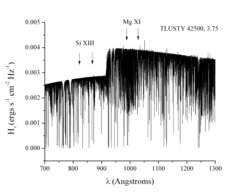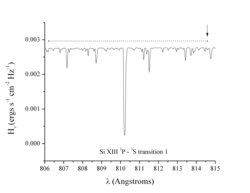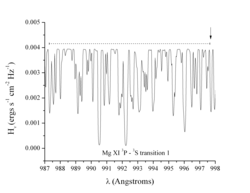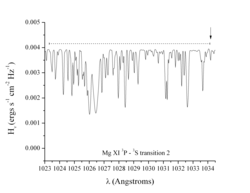HD93129: Chandra grating spectrum
Helium-like complexes
Photoexcitation from the upper level of the intercombination line(s) to the upper level of the forbidden lines alters the f/i ratios of He-like complexes in the presence of a strong UV radiation field. This line ratio is thus a diagnostic of the distance from the photosphere of the hot, X-ray emitting plasma, given an assumed -- or measured -- photospheric UV flux. Note that the spatial dependences of the emissivities of the forbidden and intercombination lines affects both the line shapes and the line intensities. We can model both these effects self-consistently, following the formalism laid out in Leutenegger et al. 2006. This paper also contains the relevant atomic parameters. Below, we use a TLUSTY model atmosphere SED with Teff = 42,500 and log g = 3.75 (after Repolust et al. 2004) to estimate the photospheric (Eddington) fluxes at the relevant wavelengths.
Here is the relevant portion of the model SED, with the photoexcitation wavelengths indicated:
Below, we zoom in on the relevant portions of the model spectrum. The arrows indicate the rest wavelengths of the two exciting transitions for each complex (Si XIII and Mg XI), while the horizontal lines indicate a range of blue shifts corresponding to the wind terminal velocity. Leutenegger et al. 2006 showed that averaging the photospheric flux over this range provides a good approximation for the overall photoexcitation rate.
6.6479, 6.6866, 6.7403 Angstroms: Si XIII
The 3P - 3S photoexcitation occurs at 814.7 and 865.2 Angstroms for Si XIII.
Based on these models, we use an average of Hν = 2.6 X 10-3 ergs s-1 cm-2 Hz-1 for Si XIII. And using the atomic parameters in Leutenegger et al. 2006, this gives phiratio = φ*/φc = 17.
9.1687, 9.2297, 9.3143 Angstroms: Mg XI
The 3P - 3S photoexcitation occurs at 997.5 and 1034.3 Angstroms for Mg XI.
Based on these models, we use an average of Hν = 3.3 X 10-3 ergs s-1 cm-2 Hz-1 for Mg XI. And using the atomic parameters in Leutenegger et al. 2006, this gives phiratio = φ*/φc = 141.
last modified: 10 August 2010






